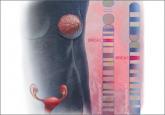From the Editor

What is the gynecologist’s role in the care of BRCA previvors?
Here, your patient’s options for surgery and your best options for her follow-up care and ongoing surveillance

The recommendation applies to asymptomatic women aged 35 years or older without a prior diagnosis of breast cancer, ductal carcinoma in situ, or lobular carcinoma in situ
Clinicians should engage in shared, informed decision-making with women who are at increased risk for breast cancer about medications to reduce their risk. For women who are at increased risk for breast cancer and at low risk for adverse medication effects, clinicians should offer to prescribe risk-reducing medications, such as tamoxifen or raloxifene, recommends the US Preventive Services Task Force (USPSTF).
RELATED ARTICLE: Update on Breast Health Mark Pearlman, MD, and Jennifer Griffin Miller, MD, MPH (March 2013)
Tamoxifen and raloxifene
These agents are selective estrogen receptor (ER) modulators and have been shown to reduce the incidence of invasive, ER-positive breast cancer in several randomized, controlled trials. Tamoxifen has been approved by the US Food and Drug Administration (FDA) for this use in women aged 35 years or older, and raloxifene has been FDA-approved for this use in postmenopausal women.
RELATED ARTICLE: Osteoporosis treatment and breast cancer prevention: Two goals, one treatment? Robert L. Barbieri, MD (Editorial, November 2013)
A systematic review of clinical trials found that tamoxifen and raloxifene reduced the incidence of invasive breast cancer by 7 to 9 events per 1000 women over 5 years. Tamoxifen was found to reduce the incidence of breast cancer more than raloxifene. Tamoxifen also reduces the incidence of invasive breast cancer in premenopausal women who are at increased risk for the disease.
USPSTF-defined high risk
Women with an estimated 5-year risk for breast cancer of 3% or more are likely to benefit from treatment with tamoxifen or raloxifene. For women with no increased risk for breast cancer, the USPSTF found that the benefit of treatment with tamoxifen or raloxifene is limited (small). The USPSTF recommends against the routine use of medications, such as tamoxifen or raloxifene, for risk reduction of primary breast cancer in women who are not at increased risk for breast cancer.
The usual daily doses for tamoxifen and raloxifene are 20 mg and 60 mg, respectively, for 5 years. Tamoxifen is not recommended for use in combination with hormone therapy or hormonal contraception or in women who are pregnant, those who may become pregnant, or breastfeeding mothers.
RELATED ARTICLE: What is the gynecologist's role in the care of BRCA previvors? Robert L. Barbieri, MD (Editorial, September 2013)
Potential harms from tamoxifen and raloxifene
Tamoxifen and raloxifene increase risk for venous thromboembolic events (VTEs) by 4 to 7 events per 1000 women over 5 years; tamoxifen increases risk more than raloxifene. The USPSTF found that potential harms from thromboembolic events are small to moderate, with increased potential for harms in older women. Neither tamoxifen nor raloxifene should be used in women who have a history of thromboembolic events (deep venous thrombosis, pulmonary embolus, stroke, or transient ischemic attack).
Tamoxifen, but not raloxifene, has been found to increase risk for endometrial cancer (4 more cases per 1000 women). Potential harms from tamoxifen-related endometrial cancer are small to moderate and depend on hysterectomy status and age. The potential risks for tamoxifen-related harms are higher in women older than age 50 and in women with a uterus. Tamoxifen may also increase the incidence of cataracts.
Vasomotor symptoms are a common adverse effect of both tamoxifen and raloxifene. These symptoms may affect a patient's quality of life and willingness to use or adhere to the medications.
The final recommendation statement was published online in the Annals of Internal Medicine September 24, 2013, and is available on the USPSTF Web site.

Here, your patient’s options for surgery and your best options for her follow-up care and ongoing surveillance
A look at findings from the estrogen-alone arm of the WHI, chemoprophylaxis for high-risk women, and fertility preservation for young breast...

For postmenopausal women with newly diagnosed osteoporosis, assessing the risk of breast cancer prior to prescribing a bone medicine could...
